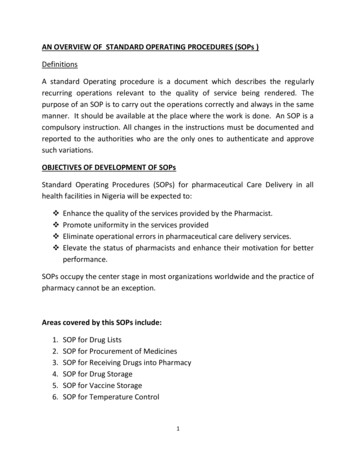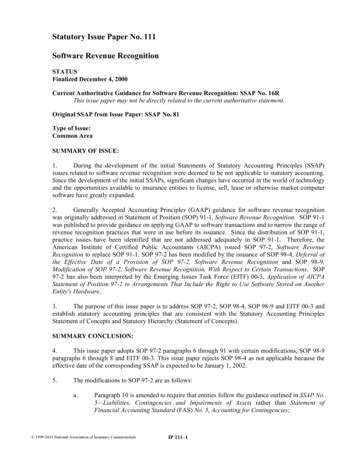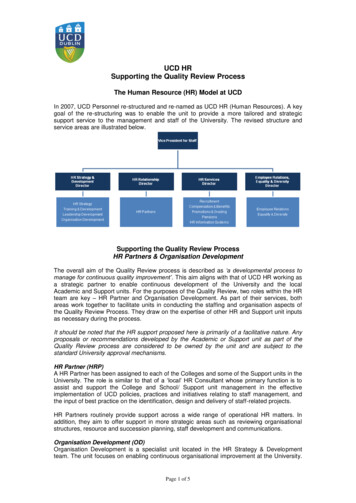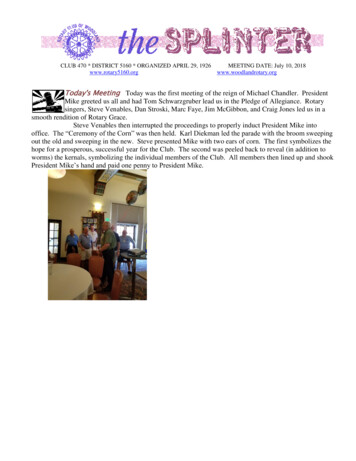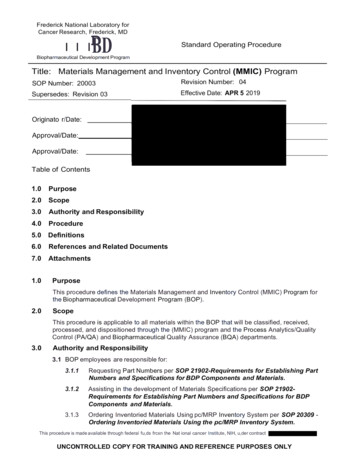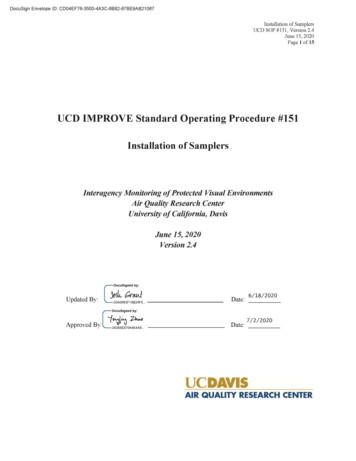
Transcription
Installation of SamplersUCD SOP #151, Version 2.4June 15, 2020Page 2 of 15TABLE OF CONTENTS1.PURPOSE AND APPLICABILITY . 22.SUMMARY OF THE METHOD. 33.RESPONSIBILITIES . 33.1 Principal Investigator . 33.2 Field Manager . 43.3 Field Technician . 43.4 Lab Technician . 43.5 Local Contact . 44.EQUIPMENT AND SUPPLIES . 54.1 Sampler Installation Equipment . 54.2 Site Calibration Equipment . 64.3 Sampling Initiation Materials . 64.4 Site Documentation Materials . 65.METHODS . 75.1 Site Preparation and Communication Procedures . 75.2 Installation of Aerosol Samplers . 95.2.1Attachment of Aerosol Sampler to the Support Structure . 95.2.2Installation of Inlets and Inlet Stacks . 95.2.3Wiring the IMPROVE Aerosol Sampler to Power . 105.2.4Connecting Pumps to the Aerosol Sampler . 105.2.5Sampler Function Check . 115.3Calibration of the Modules . 125.4Operator Training . 125.5Site Documentation . 126.REFERENCES . 137.APPENDIX A: SITE INFORMATION SHEET. 141. PURPOSE AND APPLICABILITY
Installation of SamplersUCD SOP #151, Version 2.4June 15, 2020Page 3 of 15This standard operating procedure (SOP) describes the procedures for installing new aerosolsampling sites according to IMPROVE sampling network protocol.The IMPROVE aerosol monitoring program is designed to collect quantitative information onthe composition and concentration of fine (PM2.5) aerosol particles that reduce visibility. Aerosoldata provide information to decision-makers and the public on the state of Class I area visibility,causes of visibility impairment, and trends in visibility for a region. Finally, elemental analysisof aerosol samples can identify tracers for emission sources.An IMPROVE aerosol sampling site generally has a controller and four sampling modules. Themodules run in parallel; the controller sends the same signals to each module. The four standardsampling module types are 1A, 2B, 3C and 4D. Module 1A collects fine particles (0 – 2.5µm) ona stretched Teflon filter and provides data on elemental composition of fine particles. Module2B collects fine particles (0 – 2.5µm) on a nylon filter, has a denuder before the nylon filter toremove acidic gases, and is used to quantify particulate anions (nitrate, nitrite, sulfate, andchloride). Module 3C collects fine particles (0 – 2.5µm) on a quartz filter to measure organic andelemental carbon. Module 4D collects coarse and fine particles (0 – 10µm) on a stretchedTeflon filter and provides data on PM10 mass loading. Some sites have a fifth module forcollocated precision measurements (called a 5X module), which can be a duplicate of a 1A, 2B,3C, or 4D module.Each module is independent with a separate inlet, sizing device, flow measurement system,critical orifice flow restrictor, and pump. All modules are wired to a common controller, which isprogrammed for IMPROVE sampling to collect a twenty-four hour sample every third day frommidnight to midnight.The design is simple and rugged to withstand ambient field conditions and for ease of operationand maintenance.The purpose of this SOP is to facilitate installation of IMPROVE aerosol samplers; to assureconsistent, quality data; and to minimize data loss by installing aerosol monitoring systemsaccording to design specifications and EPA requirements.2. SUMMARY OF THE METHODThe principal investigator, field manager, and local contact work together to find a suitablelocation and prepare housing for new IMPROVE monitoring sites. The procedures and criteriafor selecting new site locations are provided in UCD SOP #126: Site Selection. Lab personnelprepare boxes of filters to initiate sampling at the site. A field technician is sent to the location toinstall and calibrate the sampler, train the new operator(s), and to complete documentation of thesite.3. RESPONSIBILITIES3.1 Principal InvestigatorThe principal investigator will:
Installation of SamplersUCD SOP #151, Version 2.4June 15, 2020Page 4 of 15Approve final site configuration materials including photographic documentation,maps, installation location, and site configuration specifications. Verify funding and approval of the final site configuration and location bycontacting the agency(ies) or program(s) responsible for the funding of the site.3.2 Field ManagerThe field manager will: Schedule the aerosol sampler installation. Make suggestions on construction of the support structure for the aerosol samplerbased on the site photos and descriptions returned with the siting document. As required, review the determined site preparation and installation requirementswith the local contact. Schedule an operator training session for all identified operators and the primarylocal contact. Enter the site documentation and configuration information into the site database. Review the site calibration equations derived by the field technician. 3.3 Field TechnicianThe field technician will:Install the sampling modules at the site.Clean and test the sampling modules.Calibrate the sampling modules.Take photographs of the site and final equipment configuration and complete onsite documentation. Produce detailed directions for access to the site and create any necessary maps ofthe site location.3.4 Lab TechnicianThe lab technician will: Initiate the new site in the aerosol samples and analysis databases. Create site-specific filter and sampling date identification labels for the new site. Assemble cassettes, shipping boxes, and labels for shipping samples between UCDavis and the new site. Verify the address to which the samples will be shipped. Send out the filters to initiate sampling at the site, as scheduled by the fieldmanager. 3.5 Local ContactThe local contact will:
Installation of SamplersUCD SOP #151, Version 2.4June 15, 2020Page 5 of 15 Review the determined site preparation and installation requirements with thefield technician.Identify and contact local land owners, primary contacts, and site operatorsregarding site installation and routine maintenance requirements.Finalize contracts with land owners for site installation and power usage.Perform any necessary site preparation prior to the installation (e.g. tree or brushremoval, access road maintenance, electrical re-wiring to meet powerrequirements, aerosol sampler support structure construction, etc.).Maintain communications with the field technician and local land owners toconfirm scheduled installation requirements.Schedule operator training session with the field technicians and the fieldmanager.Provide site access and installation assistance as needed.Verify site location and geographic reference specifications documented by thefield manager.4. EQUIPMENT AND SUPPLIESThe materials required to install an IMPROVE aerosol sampler depend on the type ofinstallation: in an existing building, in a newly constructed sampler shed, or on an outdoorsstand. Other factors include how many aerosol sampling modules are being installed; up to fivesampling modules fit within standard protocol.Information for the local contact on preparing existing buildings for sampler installation,constructing new buildings to house aerosol samplers, or constructing an outdoors stand foraerosol samplers is included in Section 5.1 Site Preparation and Communication Procedures.However, as the local contact at each site will encounter different problems, no general listing ofthe equipment required for site preparation prior to sampler installation will be made.4.1 Sampler Installation EquipmentThe installation of the aerosol sampler(s) by field technicians will occur only after allsite preparations are completed. This includes ensuring adequate power supply, preparing accessroads, sampler stand with adequate roof access, or support structure construction, etc.Standard equipment and materials required for installation of aerosol samplers to collect samplesinclude: 1 aerosol sampler controllerModule 1A (PM2.5) sampler for elemental analysisModule 2B (PM2.5) sampler to analyze for nitrate, nitrite, sulfate, and chlorideionModule 3C (PM2.5) sampler to analyze for carbonModule 4D (PM10) sampler for gravimetric analysisModule 5X (where X represents A, B, C, or D) if applicable
Installation of SamplersUCD SOP #151, Version 2.4June 15, 2020Page 6 of 15 Vacuum tubing for each sampling module, long enough to run between the airsampling modules and pumpsOne pump for each sampling moduleRelay control boxes for activating pumpsOne module cable long enough for each moduleOne temperature measurement probe, long enough to fit into the airstream ofchosen module (usually 3C)One anodized aluminum inlet stack long enough to meet EPA requirementsfor each sampling module (see SOP #126, Figure 5): modules with 2.5µm cutpoints (PM2.5 samplers) require a pipe with 1/16” wall and outer diameter1.5”; modules with 10µm cut points (PM10 samplers) require a pipe with 1/16”wall and outer diameter 1.25”1 cleaned, coated aluminum denuder for the 2B module1 inlet head for each PM2.5 sampling module. Note that inlet heads for allPM2.5 modules are identical1 inlet head for each PM10 module being installed (Andersen Samplers Inc.16.7 LPM low flow rate Sierra inlet)4.2 Site Calibration EquipmentRefer to UCD SOP #226: Site Maintenance for a detailed list of equipment required to calibratean IMPROVE aerosol sampler.4.3 Sampling Initiation MaterialsThe following materials are necessary for site initiation.1) 2 boxes of unexposed filter cartridges configured for the new site and samplingdates. Each box should contain the following: 3 1A module cartridges, labeled, quality-checked, and containing pre-weighedTeflon filters3 2B module cartridges, labeled, quality-checked, and containing nylon filters3 3C module cartridges, labeled, quality-checked, and containing quartz filters3 4D module cartridges, labeled, quality-checked, and containing pre-weighedTeflon filters3 log sheets, each representing one week of cartridges for the sampler, torecord sampling data3 re-closable bags, each containing one week of cartridges for the sampler, toprevent contamination of the cassettes during shipment1 SD memory card for recording data at the site1 UPS return label or business reply USPS label (depending on the site) forreturning the box to the Air Quality Research Center lab at UC Davis4.4 Site Documentation Materials
Installation of SamplersUCD SOP #151, Version 2.4June 15, 2020Page 7 of 15The following materials are required to complete the site documentation process: One camera for site documentation photosPhotographs of the site and final equipment configurationOn-site documentation by the field technician during installationMaps of the site location and directions for access5. METHODSThis section describes site installation and documentation procedures and includes two majorsubsections, 5.1 and 5.2.5.1 Site Preparation and Communication ProceduresPrior to installation of an IMPROVE aerosol sampler, the local contact must ensure the site isprepared for sampler installation. The field technician informs the local contact of the sitepreparation and installation requirements determined as necessary by the field manager and theprincipal investigator. The local contact is then responsible for ensuring the preparations arecompleted prior to the date set for site installation. The information communicated to the localcontact must include:1) The selected site configuration, whether in an existing building, a newlyconstructed sampler shed, or on an outdoor stand. Samples of sheds (C76-NPS2841, C76-NPS-2842) and outdoors stands (C76-IS-2430) for IMPROVE aerosolsamplers may be found in the diagrams packet.2) The basic requirements for the sampler module support structure include —a. The mounting surface on the structure should consist of two horizontal 2x6studs separated by 18” center to center.b. The top of the lower 2x6 stud should be positioned roughly 52” above thefloor to ensure the cyclones are at or near eye level. For an indoors site, the distance between the top of the upper studand the top of the roof must be reported to the field manager forcalculation of the required inlet stack length. For an outdoor site, the inlet stacks must be 6 feet long unless thereare unusual circumstances.c. The mounting structure must be stable to avoid vibration or shifting of thesampler modules after installation.d. The mounting structure must be strong enough to support the weight of thesampler module(s). A complete IMPROVE set-up, with a controller andfour modules, weighs 209 lbs.e. The mounting structure must be long enough to support all of the modules,which is generally 96 inches long. An optimal spacing of the modules isroughly 24” between stack to stack. The preferred installation is all modules
Installation of SamplersUCD SOP #151, Version 2.4June 15, 2020Page 8 of 15on one wall, but if there is not enough space other walls may be usedpending approval from the field manager.f. For an indoors site, the mounting structure must be constructed in a locationwhere holes may be drilled vertically through the roof above the modulesonce mounted.g. Preparations for installation of samplers in pre-existing concrete and/ormetal structures may include additional requirements. Careful discussion ofsampler mounting options with property managers is required, as isassistance from the local contact and maintenance workers. Damage tostructural integrity is possible, and on-site supervision of installation bypersonnel responsible for the structure is required. In these situations, forinsurance purposes, the Air Quality Research Center requires the propertymanagers to approve, oversee, and hire the appropriate personnel to attachthe support structure, drill the holes for the stacks, and re-seal the roof oncethe samplers are installed. Due to these constraints, installation in preexisting concrete or metal structures does not generally occur.h. Each shelter must be equipped with a safe means of accessing the roof andstacks. A permanent staircase or ladder is preferred, but as a secondaryoption, a lean-to ladder that can be hooked to the structure may be kept atthe site. The roof should be accessible year-round.i. Pump enclosures are required for outdoor sites and recommended for indoorsites. Outdoor enclosures must be big enough to allow at least two cubic feetper pump and must be well ventilated. Indoor pump enclosures are generallyconstructed by sectioning off a portion of the shelter from the main area thathouses the modules in order to prevent heat from the pumps affecting themodules. The sectioned-off pump area must be well ventilated to preventoverheating.3) The location of installation of sampler modules — Determine which wall or surface the sampler be mounted on. Notethat if on an outdoor stand, the sampling modules are mountedfacing north. Where will each module be mounted on the wall or supportstructure? The modules are general mounted roughly 52” above thefloor or ground to put the cyclones in the modules at eye level. Also,the modules cannot be mounted closer than 5” from a corner in orderto allow the doors to open freely.4) The power requirements for the sampler. The IMPROVE aerosol sampler uses120V, 60Hz electrical power during normal use. The sampler requires two 20 ampbreakers or one 30 amp breaker. 30 amp breakers are generally discouraged due tothe required wire, breaker, and receptacle sizing. A minimum of four outlets isnecessary, preferably two for each 20 amp breaker.
Installation of SamplersUCD SOP #151, Version 2.4June 15, 2020Page 9 of 155) Obstructions to air flow, such as trees or bushes, which must be removed ortrimmed.6) Necessary site access path or road maintenance.7) What assistance, in terms of tools and equipment (e.g. four wheel drive vehicles,concrete, etc.), will be necessary for the field technicians to complete installationof the sampler.5.2 Installation of Aerosol SamplersThe IMPROVE aerosol samplers are installed on walls or stands according to site requirements.The basic configuration requirements are that all modules and inlets are located with the same airmass, as required by EPA siting documents, and the cyclones are mounted vertically for optimalefficiency. Installation procedures for IMPROVE aerosol samplers are described in the followingsubsections:5.2.1Attachment of Aerosol Sampler to the Support StructureThe local contact, prior to site installation, constructs a support structure for the samplermodules. The support must meet the requirements specified by the field manager forstrength and stability. Any special arrangements, such as installing the samplers in a preexisting building, must be made in advance in order for the installation process toproceed smoothly.The modules are attached to the 2x6 studs. The modules are checked during mounting toinsure the cyclones are vertical. The cyclones should be at or near eye level.The modules are installed in alphabetical/numerical order (e.g. 1A, 2B, etc.) from left toright and along one wall if possible. There must be enough space between modules toallow the door to stay open. A spacing of 24” between stacks is optimal.5.2.2Installation of Inlets and Inlet StacksFollowing the mounting of the aerosol sampler modules, the inlet stacks must beinstalled. The procedures for installation are listed below: Mark the location of the center hole for each stack on the ceiling using thespecial IMPROVE module mounting template. Drill a 1¾” to 2” hole (1½” to 1¾” for 4D module) centered on the marks madeon the ceiling. For modules 1A, 2B, and 3C, slide the 1.5” stacks through the holes in the roofand into the stock collars on top of the modules. Twist the stacks into thealuminum T-connectors as far as they will go. For the 4D module stack, slide the 1.25” stack through the hole in the roof and inthe top of the 4D module. Twist the stack into the top of the black funnel insidethe module until it rests on the O-ring seat inside the funnel. Then, lock it intoplace with the stack brace.
Installation of SamplersUCD SOP #151, Version 2.4June 15, 2020Page 10 of 15 For the 2B module only, install the denuder in the stack.a. Remove the stack bottom plug from the base of the stack Tee.b. Push the denuder up into the stack above the Tee, and then place the O-ringdetainer inside. Allow the denuder to rest on top of the O-ring detainer. Slip a loose-fitting roof jack over each stack, lay a bead of silicone caulk betweenthe roof jack and roof, nail or screw in the roof jack at each corner, and sealaround the edges of the roof jack and the roof with silicone caulk. Place a tightfitting second roof jack over each stack. Install the inlets at the tops of the stacks by twisting them on.5.2.3Wiring the IMPROVE Aerosol Sampler to PowerThe IMPROVE controller module is the only module containing control circuitry. Thecontroller’s power cord should be connected to a surge protector. The surge protectorshould be exclusive to the controller. Each sampling module not having controllercircuitry should be connected to the controller by the twelve-conductor wiring harness.Two relay boxes (three relay boxes for the site configured with 5 modules) and atemperature probe are also connected to the controller module. Two pumps are pluggedinto each relay box. Each relay box has a power cord. If two breakers are available, plugone relay box into each. For the site with 5 modules, the controller and 1A/2B relay boxshare one breaker, 3C/4D and 5X relay boxes share the second breaker.5.2.4Connecting Pumps to the Aerosol SamplerThe aerosol sampler uses external pumps, switched on by the circuitry in the relay boxesto produce the appropriate flow rate. External pumps reduce the weight of the samplermodules and are easier to maintain or replace. The procedures for installing pumps are asfollows:1) Set vacuum pumps upright in selected location.2) Plug the pumps into the two relay boxes connected to and switched on by thecontroller module. Follow the color code when plugging in the pumps.3) Connect the vacuum tubing from each module to the pump plugged into theoutlet labeled as switching on that module. Follow the color code.4) Verify the functionality of the pumps.a. For controller with keypad, go to the main menu and press the number 2.Make sure the pumps turn on in sequence, in alphabetical/numerical order(1A, 2B, etc.). The max orifice values should be at nominal values for thatsite.b. For controller with touch screen display, press Menu on main screen, thenEQUIMPENT TEST, and then Vacuum Test. When ready, press Start.Make sure the pumps turn on in sequence in alphabetical/numerical order.The max orifice values should be at nominal values for that site.
Installation of SamplersUCD SOP #151, Version 2.4June 15, 2020Page 11 of 155.2.5Sampler Function CheckOnce the sampler has been installed, validation procedures to verify the correct wiringand functioning of the sampler components are necessary. The following are instructionsfor sampler validation checks:5.2.5.1 Verify Module Values1) Insert audit cartridges into their matching modules. On the controllerdisplay, in the main menu, select Menu for the Menu. SelectAdvanced Menu from the next page, and enter the code “9051”. PressSubmit after typing in the code. This will take you to the maintenancemenu. Select the More button, then select Calibration.2) The first module shown is the 1A module. Press the Pump:Off buttonand the pump for module 1A should turn on. The display will showtwo values for CYC and ORI. Pressing the buttons, S1:Off, S2:Off,S3:Off, or S4:Off will turn on solenoids 1, 2, 3, or 4, respectively. Onthe CYC (Cyclone) row, the value will be displayed in inches water( ” H2O) on the left column, and liters per minute (LPM) on the rightcolumn. The ORI (Orifice) row will display the measured pressurevalue in pounds per square inch (PSI), and LPM on the right column.The LPM values are valid on the CYC column for non-4D typemodules and the LPM is valid on the ORI column for 4D type module.Check to make sure the pressures and flows are reasonable andconfirm that the pump is running. If the solenoid control button says“S1: On”, that means the solenoid is on. Pressing it again will turn it to“S2: Off”, meaning the solenoid is off. Only one solenoid should be onat a time for accurate values. Check all four solenoid positionsindividually. After verifying Module 1A values, use the button topage over to Module 2B.3) Repeat step 2 for the 2B, 3C, and 4D modules (as well as for the 5Xmodule, if applicable).5.2.5.2 Verify Integrity of the Vacuum System1) From the Home Screen, press Menu to enter Menu. Press theEquipment Tests button, then the Vacuum Test button, and then theStart button. Note these values. The MxORI/VAC values for allmodules should be less than 4 psi. Press the Stop Pumps whenfinished. This will take you back to the Equipment Tests menu.2) From the Calibration menu, described above, note the value of eachmodule’s CYC and ORI with the first solenoid (S1) on, and the pumpoff. These are the zero values for the ORI and CYC of each module.CYC should be very close to 0” H2O and ORI will be 14.7 psi at sealevel on an average day. Cycle through each module using the, and
Installation of SamplersUCD SOP #151, Version 2.4June 15, 2020Page 12 of 15buttons. Record the values for each module. Press the (Home)button to return to the Home Screen.5.3 Calibration of the ModulesBefore the site can begin running samples, the field technician must calibrate the modules.Detailed instructions on how to perform sampler calibrations can be found in UCD SOP #226:Site Maintenance.5.4 Operator TrainingThe operator training session is run by the field technician and generally lasts about one hour orless (depending on the number of people being trained and their level of experience). The sessioninvolves reviewing UCD SOP #201: Sampler Maintenance by Site Operators and answering anyquestions the operator may have about sampling and the sampling schedule. Supervised handson training is also provided. The subjects covered include: Overview of the function and operation of each sampler module Pump functioning Procedures for data recording prior to and following sampling Filter cassette installation/removal Troubleshooting Phone numbers to call if problems arise5.5 Site DocumentationSite documentation for the IMPROVE modular aerosol sampler involves completion of the SiteInformation Sheet (Form 1). This information is filed with the site documentation data collectedduring the siting procedure.Details required to complete the site configuration form are described in detail in the followingsummaries:Site Name: Record the 5 letter side code (e.g., BAND1 or THSI1).UC Code: Record the four digit University of California Inventory ID number.Date/Initials: The date the site was installed and the initials of the field technician who installedit.Shelter and Roof: List the type of shelter, its dimensions and materials used to build it, as well asa description of the shelter’s ventilation.Controller and Modules: List the configuration/order of the modules and controller, the locationand height of the modules, the sampling cycle of the site, the filter specs, the length of the
Installation of SamplersUCD SOP #151, Version 2.4June 15, 2020Page 13 of 15module cables, stack information, the location of the temp probe, E-box versions, and the E-boxcyclone zeros.Pumps: List the location of the pumps and the distances from the pump to the relay boxes, fromthe relay boxes to the electrical outlets, and from the relay boxes to the controller. Note thedimensions of the pump box (if applicable) and anything used to control the climate in the pumparea.Power: List information regarding any surge suppressors and circuit breakers. Describe wherethe electrical outlets are and what equipment is plugged into each. List the distance between eachoutlet and the controller.Surroundings: Describe the source of any potential contamination (within 300 yards of the site)and any clearance violations or issues.After site documentation has been completed, the field technician must take pictures of thefollowing: Modules Pumps Power Breakers Roof Stacks (inlets) Inward views facing the site (N, NE, E, SE, S, SW, W, NW) Outward views facing away from the site (N, E, S, W)6. REFERENCES1. UCD IMPROVE SOP #126: Site Selection for IMPROVE2. UCD IMPROVE SOP #201: Sampler Maintenance by Site Operators3. UCD IMPROVE SOP #226: Site Maintenance
Installation of SamplersUCD SOP #151, Version 2.4June 15, 2020Page 14 of 157. APPENDIX A: SITE INFORMATION SHEETIMPROVE Aerosol Monitoring Site Information SheetPlease change any information that is not current and fill in all blank fields.SITE CODE:SITE ID:DATE/INITIALS:SHELTER AND ROOF:Type:Door Dimensions (type of door and dimensions):Climate control:Wall Dimensions (height x width x depth):N:E:S:W:Roof Style (shape):Shelter Wall Material:Roof Peak Heights (floor to inner peak):Roof Material (material and shingle style):Ventilation:WallN:S:W:E:Size, Type and X,Y coordinates (0,0) bottom left of inner wallCONTROLLER AND MODULES:Sample Configuration:MOD Location (e.g. N Wall inside):Filter Specs:C (prim/sec):BLBX Sequence:Program Version:MOD Height:Floor to top of MOD:Top of MOD to roof:Cable lengths:A:B:C:D:Stacks:Anodized:Length:Braces or guide lines:Clearances:A-B:C-D:B-C:D-X:Temp Probe in MOD:
Installation of SamplersUCD SOP #151, Version 2.4June 15, 2020Page 15 of 15EBox VersionA:B:C:D:X:Pumps:Pump Location:Pump to RBOX distances:A/B:X:C/D:RBOX to Outlet D
returning the box to the Air Quality Research Center lab at UC Davis . 4.4 Site Documentation Materials . Installation of Samplers UCD SOP #151, Version 2.4 June 15, 2020 . floor to ensure the cyclones are at or near eye level. For an indoors site, the distance between the top of the upper stud . Installation of Samplers UCD SOP #151 .
